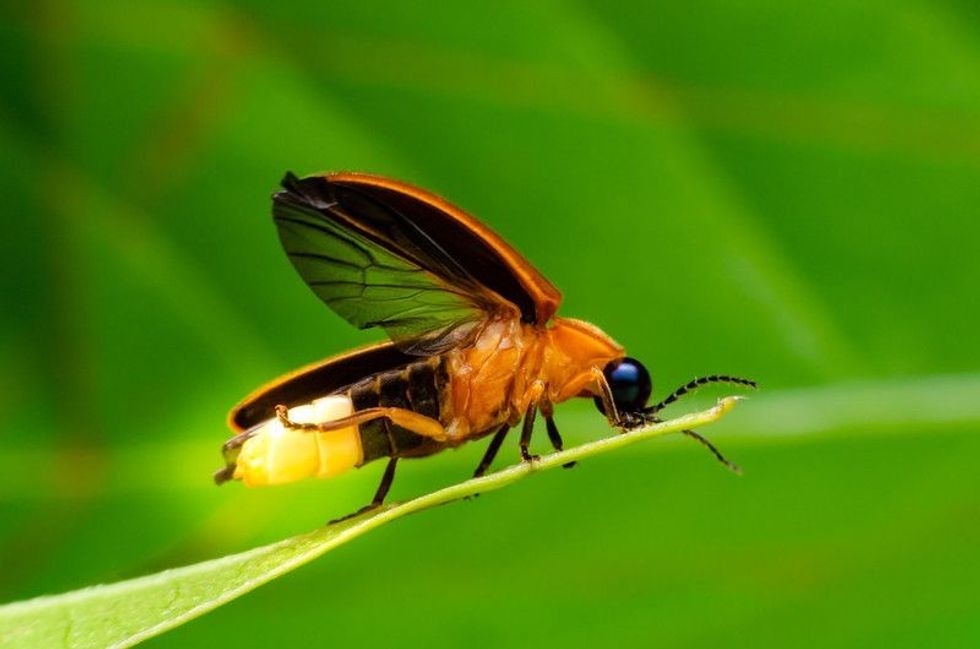Lightning bugs, or fireflies, are part of the family Coleoptera: Lampyridae.
Scientists and creatives have always been in love with these beneficial insects of the world. They are neither bugs nor flies but actually beetles.
There are more than 2000 species of fireflies in the world. Different species of fireflies have their own flash patterns. They even blink in unity sometimes.
Firefly larvae, also called glowworms, glow to frighten predators. Although they work similarly to a light bulb with heat energy and light, fireflies are known to create light using a chemical reaction called chemiluminescence. This reaction allows them to flash through without utilizing heat energy. All of the energy of a firefly goes into creating light.
A firefly's flashing also increases the metabolic rates of the insect. Fireflies are known to be bioluminescent. They are living creatures that can produce light.
Only some terrestrial insects, like railroad worms and click beetles, can do that. The light produced is used to attract the opposite sex and prey and warn off predators. Even the larvae are known to glow brightly.
If birds or predators feed on these lightning bugs, they won't like the taste of these insects. Fireflies are not seen much in their larvae stage.
They only fly around as adults. Firefly eggs, pupae, and larvae are known to produce light. The parts of fireflies that are known to show light signals are called lanterns.
Fireflies are able to control the flash patterns in their life cycles with nitric oxide and neural stimulation. The males are known to flash in unison with other males during courtship.
Flashing is seen as common in these soft-bodied insects. The colors of these flashing lights are different in different species. Some show orange colors, while there have been instances of yellow-green, bright poppy red, and turquoise colorations.
Is it safe to touch fireflies?
Chances to catch fireflies or lightning bugs during childhood have always been a fond memory for children worldwide. Hundreds of small lights and flashes are seen on a summer night, so children and adults run around to catch these insects and preserve them.
Fireflies are not known to be poisonous or harmful. They don't even sting or bite. Fireflies are the perfect companions for a family full of children and adults. To keep them safe and healthy after catching them, put them in a jar without any holes.
People often say holes should be made in the jar to let air come in. However, holes can dry the insects. You can add a coffee filter, moist paper towel, or some apples to keep them hydrated and the humidity controlled.
Sometimes fireflies can be pretty helpful apart from glowing up a summer night. Lightning bugs have luciferase and luciferin that are used for research on multiple sclerosis, cancer, cystic fibrosis, and heart disease.
Do fireflies bite or sting?
Fireflies have always been friendly. Fireflies are not known to bite or sting and do not carry any disease. They do not become a pest in your garden or eat your crops. They just light up your garden for a perfect view.
Fireflies are actually beetles of the family Lampyridae. The bioluminescent light pattern they show is used to communicate with each other.
It is also used to attract mates or send a warning. The light comes from the underside of the abdomen, from an organ in which oxygen has a reaction with luciferin (light-emitting pigment) in the presence of luciferase to emit photons and create light.
Fireflies do not have stingers or fangs to defend themselves. They use their light to warn predators and shoo them away. This warning coloration technique is common among animals. Wasps and bees use striking patterns and bright colors to warn animals.
Warning coloration is also used by animals that do not have any external defense mechanisms. This is done by animals that are poisonous to eat. Warning coloration is seen in insects that are too small to cause any damage to bigger predators.
Most common colorations include bright colors like yellow, red, and orange and are paired with colors like black. Fireflies do not adopt this technique. Instead of warning colorations, they use bioluminescence (the result of a chemical reaction).
Are they cannibals?

It needs to be discovered what adult fireflies feed on. Most species don't seem to feed, while others eat pollen or mites.
However, Photuris fireflies eat other fireflies. The females of this species of fireflies enjoy eating males of other genera. These Photuris species are called femmes fatales. They aggressively mimic to find food.
When a male firefly of a different genus flashes the light signal, the female Photuris sends the same flash pattern back. The male thinks that the female Photuris firefly is a receptive mate of his own species. The female continues to sway the male until the latter is within her limits. She pounces on the male.
Adult female fireflies of this species are also known to be kleptoparasitic. They feed on silk-wrapped Photinus species fireflies hanging from a spider's web.
They sometimes even eat one of their own species. Spiders and adult female Photuris fireflies have been seen engaging in fierce battles. Sometimes the firefly wins and gets the silk-wrapped meal, while at other times, the spider wins and gets two meals instead.
Do female fireflies eat the males?
Female fireflies from the genus Photuris eat the male fireflies of the genus Photinus. The females trick the males by faking the flash signals of the Photinus females. When Photuris females prey on Photinus males, they get more than nutrients. They also receive lucibufagins, defensive steroidal pyrones, packed in Photinus males.
Photuris females are unable to produce this pyrone of their own. Phidippus jumping spiders are known to reject Photuris females that acquire lucibufagin. The pyrone helps them stay away from at least one predator of the world.
Conserving fireflies
The lightning bugs have been on the decline these past couple of years. This is why they are seen less nowadays during the summer. Human development of the habitats of these fireflies, light pollution, and harvesting has led to a decrease in the population of fireflies. Fireflies are not known to relocate when their habitat gets destroyed.
Two places in the world see simultaneous bioluminescence (where thousands of fireflies flash simultaneously). These two places are the Great Smoky Mountains National Park and Southeast Asia. You will see Photinus carolinus in North America lighting up the dark sky in late spring.
The Pteroptyx species in Southeast Asia show the most beautiful show with their mass synchronous display. Thousands of males of this firefly species meet in groups and emit rhythmic courtship flashes. This group is called leks.
You will see these abundantly in the Selangor River in Malaysia. Lek courting is also seen in American fireflies. However, in America, it is only for short periods.
Males of Phausis reticulate, the blue ghost firefly in the American Southeast glow as they fly through the forest floor looking for females. You will see them around 40 minutes after sunset and until midnight. Both males and females give out a nearly continuous glow in the forests of Appalachia.
Saving all the firefly species is crucial as they constitute a building block for this world.










